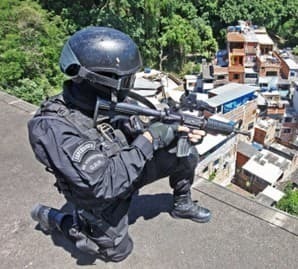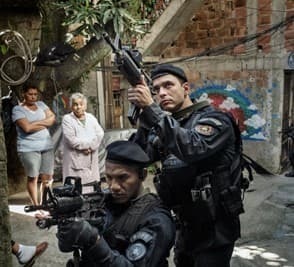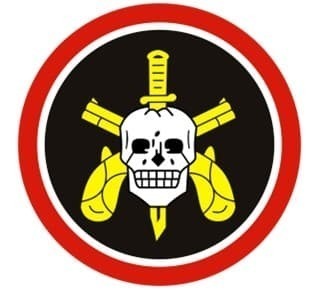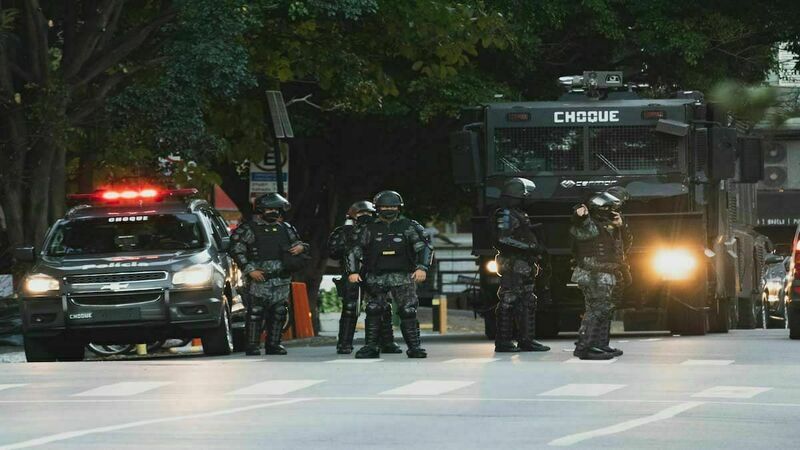Introduction: The Psychology of Police Uniforms
Between October and December of 2019, Dr. Michael Rowe—a professor in the Department of Social Sciences and Languages at Northumbria University in the United Kingdom—and his team of social researchers interviewed the officers and affiliated staff of four police stations across North England in 28 semi-structured interviews for their investigation on the relationship between police uniforms and perceived police occupational identity (Rowe et al. 226). In this study, officers were asked to present any object that they felt best encompassed their identity as a police officer. Of the 36 objects presented, 31 (86%) contained symbolism or iconography of policemen—such as police cars or the “thin blue line” imagery—and of these 31, 20 (65%) were related to police uniforms (Rowe et al. 227). In a separate study conducted by researchers at the University of Chicago in 1982, citizens not affiliated with the realm of law enforcement were asked to identify the icons and symbols that they most associated with the police (Balkin and Houlden 24). Of the responses, the overwhelming majority of participants chose a police uniform or pieces of a police uniform, such as a police badge, as the symbol they most associated with law enforcement (Balkin and Houlden 27).
The tightly intertwined relationship between police uniforms and the police force is almost as old and traditioned as the field of law enforcement itself. Since nearly the birth of law enforcement, police uniforms have existed primarily for two reasons: the first of which is to help distinguish law enforcement officers from everyday citizens and military members, whose uniforms theirs closely resembled, and the second of which was to establish perceptions of authority, power, and order, while additionally incentivizing those around uniform-wearers to obey the law and their superiors (Johnson 28).
Equally—if not, more—important to the relationship between the police force, police uniforms, and their sociological and psychological impacts and perceptions is the close association between police and military uniforms. Since the very inception of police uniforms, with the first modern standardized law enforcement apparel created by the London Metropolitan Police in 1829, police uniforms have predominantly—and remain nearly completely—fashioned in paramilitary-styles (Johnson 27; Shults). The London Metropolitan Police’s first uniform was designed to be almost identical to the uniforms worn by officers in the British military, save minor differences between the hats worn between the two forces and the fact that the British military uniform was red and white while the London Metropolitan Police’s uniform was intentionally colored a distinct navy blue (Johnson 27).
In recent years, with the rise of publicized instances of police brutality and extrajudicial killings involving police across the globe, the paramilitary-like structure of police forces around the world has come under great scrutiny. One major focus of this scrutiny has been the visual psychology, social interactions, and symbolism resulting from stylistic choices in police uniform designs internationally. Police uniforms are more than just garments: when an officer puts on their uniform, they wear an attire that “conveys power and authority,” “[embodies the] stereotypes about all police officers,” and “change how citizens perceive them” (Johnson 27). Additionally, both psychological and sociological research, which will be discussed more in-depth later in this essay, support the conclusion that donning a police uniform can greatly impact the wearer’s behavior and notions of justice, individuality, and blame. This paper aims to investigate this overall area of criticism by exploring the impact of militarized or paramilitary-style police uniforms on policing policies and public perceptions of and reactions to law enforcement.
To execute these research objectives, the uniforms of the Batalhão de Operações Policiais Especiais (“Special Police Operations Battalion,” or BOPE) of Brazil will be analyzed as a case study in two ways: the uniform colors and components and the iconography used. Additionally, this paper will follow Kraska and Kappeler’s definition of militarization as “a set of beliefs and values that stress the use of force and domination as appropriate means to solve problems and gain political power, while glorifying the tools to accomplish this, [such as] military power, hardware, and technology” (Kraska and Kappeler, 1). Paramilitary-style will be identified by two factors: (1) both the implicit and explicit intentions of the individuals and organizations who created the designs, such as if these intentions directly describe the designs as “paramilitary,” and (2) the visual closeness between the police uniform designs and military uniform designs, with particular consideration to if the police uniform designs were inspired directly by the latter.
Introduction to BOPE
José Padilha’s hit 2010 movie, Tropa de Elite 2: O Inimigo Agora é Outro (“Elite Squad 2: The Enemy Within”) begins to introduce the central conflict of the film—that is, the corruption and inequality deeply ingrained within and perpetuated by almost every single structure in Rio de Janeiro—with the remark about BOPE by the character Diogo Fraga, “Isn’t it strange? A police force that has a skull for a logo.” Fraga’s observation is eventually substantiated in two major manners. This is done firstly through depictions of BOPE’s unremorseful use of violence and fear against disproportionately marginalized communities, namely favelados, or inhabitants of favelas, which are regions or neighborhoods stricken by poverty, which, in the film, Fraga comments are being “ethnically and socially cleansed” intentionally by BOPE (“Favela”; Tropa de Elite 2: O Inimigo Agora é Outro). Secondly, this is shown through BOPE’s Captain Roberto Nascimento’s realization later into the film that although BOPE prides itself on not being corrupt like other organizations—especially other law enforcement organizations—they are an equal participant in the cycle of corruption as the violence and force that BOPE uses not only perpetuate slum-like conditions in favelas, but also protect and serve corrupt authority figures who create and profit off of these conditions by acting as their ideal, blindly-loyal agency of execution (Tropa de Elite 2: O Inimigo Agora é Outro). In real life, this can be substantiated by a multitude of occurrences and criticisms, such as the peace organization Amnesty International’s report on how BOPE’s violent tactics have only bred further chaos in Rio de Janeiro, and evidence of BOPE’s involvement in highly questionable extrajudicial killings (“Brazil: ‘They Come in Shooting’: Policing Socially Excluded Communities”).
These physical substantiations—real and from the movie—are all extremely important towards the argument that the paramilitary-like structure and militarization of police forces are extremely dangerous constructs that can be—and frequently are—taken advantage of and/or used as perpetrators of violence and injustice, even when they themselves are innocent in intentions. This paper would like to take a further investigation into this statement by Fraga by analyzing how the violent actions of BOPE, their fatal flaw of blind devotion—as shown in Tropa de Elite 2: O Inimigo Agora é Outro—and their occupation as a tool for perpetuating and protecting corruption is related to and enhanced by the design of their uniform and its impacts.
But first, in order to properly examine BOPE’s uniforms and their implications, one must first understand what BOPE is and what the organization does. According to the force itself, BOPE is a tactical unit of the Brazilian military police that is involved in many high-level and dangerous operations, such as dealing with drug gangs and crime in favelas (“Símbolo”). As indicated, the activities, structure, actions, and behavior of BOPE are extremely paramilitaristic, as they are literally a militarized police organization. Thus, it can be concluded that the stylistic choices of BOPE are associated with the military and military imagery. However, since BOPE is still considered to be a police force, it is not a military exception when discussing how imagery and police uniform presentation affects policing and the public’s perceptions of them.
Examining the Use of Uniform Colors and Components
While BOPE has an array of uniforms for various occasions in a multitude of colors, including camouflage prints in shades of dark or muted greens, they are frequently pictured in all-black uniforms, some of which are tactically designed with black helmets, goggles, and balaclava-like face coverings presented in Fig. 1 below, and some of which are styled more for public display, such as the all-black uniforms with black berets that were seen during the 2016 Olympic games in Rio de Janeiro in Fig. 2 below.
Although BOPE’s uniform color choices are primarily made due to their maximization of the wearer’s stealth, which allows the BOPE officers to conduct their operations in greater safety and efficiency, this can only really be applied to more tactical uniforms, such as the one shown in Fig. 1 or the muted-green camouflage uniform described above. The uniform color in Fig. 1 allows the wearer to blend in and hide amongst urban environments better, such as in shadows or alleyways, while a camouflage uniform would allow the wearer to blend in better with more rural locations by matching the color scheme of the flora and fauna around them. Additionally, darker uniforms tend to be useful in that they can be kept cleaner than lighter uniforms (Blaskovits et al. 212).


This argument can’t really be made for the uniform pictured in Fig. 2, which is arguably much more of a public display-styled uniform based on two observations. Firstly, one of the main components of the uniform, which is the black beret, is largely useless tactically, as it doesn’t protect the wearer or enhance their safety or physical capabilities—such as blocking out glare and sunlight to improve aim—in any fashion. Secondly, these were the uniforms worn by BOPE officers during the 2016 Olympics in Rio de Janeiro where they were sighted and photographed by the public, suggesting that the uniforms were not intended for stealth—at least, primarily—but rather that they were designed more for public display. Additionally, it can be observed that some components of the uniform can be removed by the choice of the wearer, as one of the officers pictured in Fig. 2 is wearing black gloves but the other is not. Although this could just be an indicator of personal preference based on which individual preferred to wear the gloves while holding a gun or which individual preferred to wear gloves based on the weather at the time, it can also indicate that some components of the uniform are not primarily tactical. Regardless of if the additional observation is an indicator of the uniforms being more for show than for tactic use, the question of why black was selected for the uniform color in Fig. 2 still arises from the main two observations.
Psychological research throughout the years has shown that color has a powerful ability to evoke emotions and associations in viewers. For example, the color black is “traditionally a symbol of darkness, evil, and impurity,” which is frequently why evil or villainous characters in media are often portrayed wearing black (Lupo 5). Meanwhile, the color white is “traditionally a symbol of cleanliness, goodness, and purity,” which is why “good,” pure, or heroic characters in media are often portrayed wearing white (Lupo 5). This association manifests in very literal and physical ways, such as the way that participants in studies are more likely to react negatively towards black and other dark colors than white and other light colors (Hemphill).
It seems anti-intuitive marketing-wise, then, to dress police officers—who are supposed to be protecting and promoting goodness—in black, a color that is associated with evil and immorality. Yet, additional studies show that police officers in black attire are more likely to be perceived as “stronger, confident, and more prepared for threatening behavior [or] dangerous situations,” though these officers are also more likely to be feared (Blaskovits et al. 223). In a study conducted on individuals’ responses to police officers wearing darker, particularly black, uniforms, a majority of participants indicated that they believed an officer wearing a darker uniform was “more intimidating,” “less likely to use communication to de-escalate solutions,” “more likely to use excessive force, less likely to follow rules during an arrest,” and “less apt to argue with, attempt to resist, or … overpower” than an officer wearing a lighter uniform (Blaskovits et al. 223). Considering that BOPE is a tactical police unit involved in many violent and high-level operations, it seems that selecting black for the color of the BOPE uniform in Fig. 2 is more likely to be a result of wanting to elevate and emphasize the power, strength, and capabilities BOPE officers have while simultaneously demanding respect and even submission from those around them due to the associations between black uniforms and intolerance, violence, and force.
The black beret component of the uniform pictured in Fig. 2 can also be analyzed for symbolic meaning and impact. For one, psychological studies conducted on the influence of including hats and caps in police uniforms on the way the public perceived them concluded that adding hats or caps to uniforms resulted in participants perceiving the wearer as being more intimidating, less friendly, and less helpful (Mauro 42). This was largely attributed to the fact that hats and caps tend to create or emphasize the wearer’s figure more, and since the design of many police hats and caps are angular and angularity is often associated negatively due to its implications of danger and harm, increasing the angularity of the wearer’s figure is less likely to invoke feelings of safety and comfortability (Mauro 42).
Additionally, the beret is especially interesting because it is historically strongly regarded as a symbol of revolution, “non-conformism, resistance, and militance,” which is one of the reasons why revolutionary groups, such as the Black Panther Party in the United States of America adopted it (Taylor). Additionally, they are a common component of many military uniforms across the world, which—understanding that BOPE is a militarized police force that models many of its tactics, structures, and uniforms off of a military-like structure—makes sense to include as part of a BOPE uniform (Taylor).
Consistent with the studies discussed above, the association of black as a color and black clothing with evil and violence is statistically substantiated, as organizations that wear black uniforms—such as sports teams—are more likely to be prone to violence or breaking rules (Blaskovits et al. 223). These findings are also consistent with black military uniforms, as statistically, police forces that don black uniforms are shown to be less prone to de-escalation tactics and more prone to perpetuating “power inequalities” and “mechanisms of social control” than when the same police forces wear lighter uniforms (Paul and Birzer 121). Essentially, it can be concluded that wearing a black uniform that is associated with power and intolerance does, to some degree, cause the individual wearing the uniform to “[embody the] stereotypes” surrounding that uniform and adopt behaviors that match the perception others have of officers wearing darker uniforms (Johnson 27).
Guardian Angels Who Wear Skulls: Examining BOPE’s Logo
Perhaps the most controversial element of BOPE’s uniform is their logo, which is worn on patches on their uniforms and on their berets. The full logo, which is depicted below in Fig. 3 is composed of a red circle with a smaller, black circle inside that contains two pistols and a human skull with a knife through its head. The last component of the logo is called the “faca na caveira,” or “knife in the skull” which, according to the organization, represents a “victory over death,” though many others don’t seem to share the same feelings of empowerment from the logo as BOPE (Barrionuevo; “Símbolo”). As a combination of the dangerous operations that BOPE conducts regularly, as well as their reputation for violence and their logo containing a symbol of death, BOPE has been nicknamed the “Death Squad” by numerous Brazilian and international newspapers (Barrionuevo). Death squads are viewed extremely negatively all throughout the world, as they have been attributed to millions of deaths, hundreds of thousands of injuries, and extreme destruction both physically, socially, economically, and politically all across the globe in just the past 30 years alone (Campbell 1). Additionally, it’s important to note that the presence and actions of death squads around the world historically resulted in questions about “the very legitimacy and substance of the state” that they were under (Campbell 1). Such a negative and heavy nickname given to BOPE as a result of their logo clearly shows the discomfort that many individuals feel as a result of the iconography used in the logo. Additionally, this response can suggest that as a result of BOPE’s logo, individuals perceive the organization as being as brutal, deadly, destructive, and negative as historical death squads, as well as suggesting the idea that the very existence and operation of BOPE may call into question the legitimacy of the state of Brazil that sponsors and utilizes the organization.
To begin analyzing the implications of the iconography and its symbolism, one can begin with the colors used. In the previous section, this paper established the fact that the color black often evokes negative feelings and associations, such as associations with evilness, violence, villainousness, and brutality. Additionally, the color red is often associated with relatively negative things as well, such as sacrifice, blood, courage, and danger (Hemphill). The yellow coloring of the pistols and knife can be a reference to the Brazilian flag, or serve to glamorize the weaponry depicted in the logo, as gold is often perceived positively.
Next, the iconography of the logo can be examined. Above, this paper discussed how the use of the “knife in the skull” could represent death, since skulls are associated with mortality. Additionally, the “knife in the skull” could be perceived as use of excessive force and a general detachment from remorse, as an organism must be dead in order for someone to extract a skull from them, yet the knife through the skull suggests that the violence of BOPE continues even after death and attacks what cannot fight back, such as the skull, which is already dead (Nickels 82).

Overall, studies substantiate the mass discomfort experienced by the public in response to BOPE’s logo. First and foremost, as proven in the previous section, colors and imagery associated with negative connotations—such as black with evilness or weaponry with militancy—evoke negative emotions in those observing them. Additionally, studies show that the inclusion of violent images, such as the depiction of weaponry, death, and excessive force, leads participants to feel more unsafe and wary (Nickels 82).
Moreover, from the data provided in the previous section, it can be concluded that when individuals—not just police officers—don clothing, colors, or symbols that represent certain things, particularly negative connotations, they are likely to adopt some of the qualities of the stereotypes associated with those colors, symbols, etc. to some degree. This was examined in how both police forces and sports teams were more likely to react violently and break rules when wearing darker colors, particularly black, than when they were wearing lighter colors (Blaskovits et al. 223). Additional data demonstrates that police forces and officers that don violent imagery, such as that of weaponry or skulls—like the Marvel Comics’ Punisher skull logo that has become extremely popular among American policemen in the past few years—are more likely to act in ways associated with the negative connotations brought on by these icons and symbols, such as being less patient, cooperative, and clear-headed and being more rash, violent, and rule-breaking (Cronin). This is shown to occur even when the organizations or individuals using the icons or symbols claim they represent something positive, such as how many American cops claim that they use the Punisher logo because it represents strength and a strong moral compass that is unfettered by the cruel and sometimes unjust systems around them (Cronin).
Ironically, in the scenario of American policemen using the Punisher logo, these individuals and organizations tend to act in ways that actually oppose the statements that they claim these logos empower them to behave in, such as standing up for what is right even at the cost of fighting the system (Cronin). Essentially, interestingly enough, the general conclusion supported by research tends to be that when police forces use violent symbols and icons and wear uniforms that convey a sense of a lack of safety or an increased chance of violence towards viewers, they are more likely to be involved in instances of corruption and immorality, such as police brutality.
Conclusions
The relationship between police uniforms and the individuals and organizations that wear them are as old, prominent, and traditioned as the very field of law enforcement. Additionally old is the relationship between police forces and their paramilitary tendencies. Amidst the recent rise of publicized instances of police brutality and extrajudicial killings or actions conducted by police officers and forces across the globe, these relationships—as well as all other forms of connection between the police and their military counterparts, and the growing militarization of the police—have been called into question. This paper sought to investigate the criticism aimed at the militarization of police uniforms and their stylistic choices by exploring the impact of militarized or paramilitary-style police uniforms on policing policies and public perceptions of and reactions to law enforcement using the uniforms of the Batalhão de Operações Policiais Especiais (“Special Police Operations Battalion,” or BOPE) of Brazil as a case study.
This paper specifically focused on two areas of the BOPE uniforms: the color of the uniforms and the imagery used on them. Ultimately, this paper concluded that the stylistic choices made in the BOPE uniforms, such as opting for darker colors—particularly black—on uniforms that don’t necessarily need darker colors for strategic or tactical reasons are used to express strength and power and command respect. Additionally, this paper concluded that as a result, these uniforms increase the likelihood of the wearer to act rashly and violently, absorbing—to some extent—the stereotypes and associations that come with the uniform’s colors. Moreover, this paper analyzed that the icons and symbols used on BOPE’s logo, particularly the “knife in the skull” icon, evoke strongly negative emotions in viewers. Additionally, this paper substantiated using previous research studies that when organizations, particularly policing organizations, use violent iconography and symbols, such as skulls and depictions of weaponry—both of which BOPE’s logo incorporates—these individuals and organizations are more likely to perpetuate violence, brutality, and inequality, as well as contradict the positive symbolism these icons are claimed to evoke.
Works Cited
Balkin, Steven, and Pauline Houlden. “Reducing Fear of Crime through Occupational Presence.” Criminal Justice and Behavior, vol. 10, no. 1, Mar. 1983, pp. 13–33, https://doi.org/10.1177/0093854883010001002.
Barrionuevo, Alexei. “A Violent Police Unit, on Film and in Rio’s Streets.” The New York Times, 14 Oct. 2007, www.nytimes.com/2007/10/14/world/americas/14tropa.html.
Blaskovits, Brittany, et al. “The thin blue line between cop and soldier: examining public perceptions of the militarized appearance of police.” Police Practice and Research, vol. 23, no. 2, 5 Feb. 2021, pp. 212–235, https://doi.org/10.1080/15614263.2021.1889378.
“Brazil: ‘They Come in Shooting’: Policing Socially Excluded Communities.” Amnesty International, 2 Dec. 2005, www.amnesty.org/en/documents/AMR19/025/2005/en/.
Bucher, Michael. “Inside Rio’s Elite Police Force.” TIME, 11 Aug. 2016, time.com/4434431/rio-brazil-elite-police-force/.
Campbell, Bruce B. “Death Squads in Global Perspective.” Palgrave Macmillian, 2000, pp. 1–26, https://doi.org/10.1057/9780230108141_1.
Cronin, Brian. “A History of The Punisher Logo Being Used By Police, Military & Politicians.” CBR, 17 July 2019, www.cbr.com/punisher-history-logo-used-police-military-politicians/.
“Favela.” Encyclopædia Britannica, Encyclopædia Britannica, Inc., 9 Oct. 2023, www.britannica.com/topic/favela.
Hemphill, M. “A note on adults’ color-associations.” The Journal of Genetic Psychology, vol. 157, no. 3, 1996, pp. 275-280. https://doi.org/10.1080/00221325.1996.9914865.
Horn, Marcelo. Em 2013, o Bope ganhará uniformes camuflados, preparados para serem mais resistentes à umidade e ao atrito. 2013. Rio de Janeiro.
Johnson, Richard R. “Psychological Influence of the Police Uniform.” FBI Law Enforcement Bulletin, vol. 70, no. 3, Mar. 2001, pp. 27–32, https://www.ojp.gov/ncjrs/virtual-library/abstracts/psychological-influence-police-uniform.
Lupo, Amber Kristin. “Black Police Uniforms Implicitly Increase Hostile Perceptions and Behavior.” ProQuest, The University of Texas at El Paso, ProQuest Dissertations Publisher, 2017, pp. 1–71, https://www.proquest.com/docview/2015681384?fromopenview=true&pq-origsite=gscholar&parentSessionId=s3rwh4qSyS9ZF%2FGje9%2FyywKDz%2F5VeggN1yLa3%2Fa8vFo%3D. Accessed 1 Nov. 2023.
Mauro, Robert. “The Constable’s New Clothes: Effects of Uniforms on Perceptions and Problems of Police Officers.” Journal of Applied Social Psychology, vol. 14, no. 1, Feb. 1984, pp. 42–56, https://doi.org/10.1111/j.1559-1816.1984.tb02219.x.
Kraska, Peter B., and Victor E. Kappeler. “Militarizing American Police: The Rise and Normalization of Paramilitary Units.” Social Problems, vol. 44, no. 1, February 1997, pp. 1-18. https://lsa.umich.edu/content/dam/sid-assets/SID%20Docs/_Militarizing%20America%20Police._.pdf.
Nickels, Ernest. “Good guys wear black: uniform color and citizen impressions of police.” Policing: An International Journal, vol. 31, no. 1, 29 Aug. 2007, pp. 77–92, https://www.emerald.com/insight/content/doi/10.1108/13639510810852585/full/html
Paul, John, and Michael L. Birzer. “Images of power: An analysis of the militarization of police uniforms and messages of service .” Free Inquiry in Creative Sociology, vol. 32, no. 2, 1 Nov. 2004, pp. 121–128, https://ojs.library.okstate.edu/osu/index.php/FICS/article/view/1530.
Rowe, Michael, et al. “Visible policing: uniforms and the (re)construction of police occupational identity.” Policing and Society, vol. 33, no. 2, 13 Aug. 2022, pp. 222–237, https://doi.org/10.1080/10439463.2022.2096608.
Shults, Joel F. “Is Paramilitary Structure Bad?” National Police Association, nationalpolice.org/main/is-paramilitary-structure-bad/. Accessed 29 Oct. 2023.
“Símbolo.” BOPE Operações Especiais, web.archive.org/web/20160225082828/www.bopeoficial.com/valores/simbolo/. Accessed 1 Nov. 2023.
Taylor, Nateya. “ More than a Fashion Statement.” Smithsonian, 16 Sept. 2022, nmaahc.si.edu/explore/stories/black-panther-party-uniform.
Tropa de Elite 2: O Inimigo Agora é Outro. Dir. José Padilha. Perf. Wagner Moura, André Ramiro, and Irandhir Santos. Zazen Produções, 2007. https://reserves.library.nd.edu/courses/202310_14447/reserves/191914.

